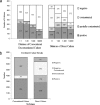Tuberculosis diagnosis and multidrug resistance testing by direct sputum culture in selective broth without decontamination or centrifugation
- PMID: 18448689
- PMCID: PMC2446921
- DOI: 10.1128/JCM.02476-07
Tuberculosis diagnosis and multidrug resistance testing by direct sputum culture in selective broth without decontamination or centrifugation
Abstract
Tuberculosis culture usually requires sputum decontamination and centrifugation to prevent cultures from being overgrown by contaminating bacteria and fungi. However, decontamination destroys many tuberculous bacilli, and centrifugation often is not possible in resource-poor settings. We therefore assessed the performance of Mycobacterium tuberculosis culture with unprocessed samples plated directly by using tuberculosis-selective media and compared this procedure to conventional culture using centrifuge decontamination. Quadruplicate aliquots of strain H37RV were cultured in 7H9 broth with and without selective antimicrobials and after centrifuge decontamination. The subsequent comparison was made with 715 sputum samples. Split paired sputum samples were cultured conventionally with centrifuge decontamination and by direct culture in tuberculosis-selective media containing antibiotics. Centrifuge decontamination reduced tuberculosis H37RV colonies by 78% (P < 0.001), whereas direct culture in tuberculosis-selective media had no inhibitory effect. Similarly, in sputum cultures that were not overgrown by contaminants, conventional culture yielded fewer tuberculosis colonies than direct culture (P < 0.001). However, the sensitivity of conventional culture was greater than that of direct culture, because samples were less affected by contamination. Thus, of the 340 sputum samples that were tuberculosis culture positive, conventional culture detected 97%, whereas direct culture detected 81% (P < 0.001). Conventional and direct cultures both took a median of 8.0 days to diagnose tuberculosis (P = 0.8). In those direct cultures that detected drug resistance or susceptibility, there was a 97% agreement with the results of conventional culture (Kappa agreement statistic, 0.84; P < 0.001). Direct culture is a simple, low-technology, and rapid technique for diagnosing tuberculosis and determining drug susceptibility. Compared to that of conventional culture, direct culture has reduced sensitivity because of bacterial overgrowth, but in basic laboratories this deficit may be outweighed by the ease of use.
Figures




Similar articles
-
Microscopic observation drug susceptibility assay, a rapid, reliable diagnostic test for multidrug-resistant tuberculosis suitable for use in resource-poor settings.J Clin Microbiol. 2004 Oct;42(10):4432-7. doi: 10.1128/JCM.42.10.4432-4437.2004. J Clin Microbiol. 2004. PMID: 15472289 Free PMC article.
-
[Advantages and drawbacks of expectoration decontamination methods for tuberculosis and anti-tuberculosis drug resistance diagnosis].Ann Biol Clin (Paris). 2013 May-Jun;71(3):283-91. doi: 10.1684/abc.2013.0815. Ann Biol Clin (Paris). 2013. PMID: 23747665 Review. French.
-
Feasibility, diagnostic accuracy, and effectiveness of decentralised use of the Xpert MTB/RIF test for diagnosis of tuberculosis and multidrug resistance: a multicentre implementation study.Lancet. 2011 Apr 30;377(9776):1495-505. doi: 10.1016/S0140-6736(11)60438-8. Epub 2011 Apr 18. Lancet. 2011. PMID: 21507477 Free PMC article.
-
Evaluation of microscopic observation drug susceptibility assay for detection of multidrug-resistant Mycobacterium tuberculosis.J Clin Microbiol. 2007 Apr;45(4):1093-7. doi: 10.1128/JCM.01949-06. Epub 2007 Jan 24. J Clin Microbiol. 2007. PMID: 17251409 Free PMC article.
-
A simple and economical in-house phage technique for the rapid detection of rifampin, isoniazid, ethambutol, streptomycin, and ciprofloxacin drug resistance in Mycobacterium tuberculosis, directly on decontaminated sputum samples.Int J Infect Dis. 2012 May;16(5):e332-6. doi: 10.1016/j.ijid.2011.12.016. Epub 2012 Feb 26. Int J Infect Dis. 2012. PMID: 22369736
Cited by
-
Effect of 1.5% sodium hydroxide final concentration on recovery rate of Mycobacterial Species and decontamination of other Bacterial and Fungal contaminants on sputum.Ethiop J Public Health Nutr. 2016;1(1):57-67. Ethiop J Public Health Nutr. 2016. PMID: 30976752 Free PMC article.
-
Identification of Novel RD1 Antigens and Their Combinations for Diagnosis of Sputum Smear-/Culture+ TB Patients.Biomed Res Int. 2016;2016:7486425. doi: 10.1155/2016/7486425. Epub 2016 Jan 18. Biomed Res Int. 2016. PMID: 26885516 Free PMC article.
-
Optimising fluorescein diacetate sputum smear microscopy for assessing patients with pulmonary tuberculosis.PLoS One. 2019 Apr 30;14(4):e0214131. doi: 10.1371/journal.pone.0214131. eCollection 2019. PLoS One. 2019. PMID: 31039160 Free PMC article.
-
A Novel Microfluidic Dielectrophoresis Technology to Enable Rapid Diagnosis of Mycobacteria tuberculosis in Clinical Samples.J Mol Diagn. 2023 Jul;25(7):513-523. doi: 10.1016/j.jmoldx.2023.04.005. J Mol Diagn. 2023. PMID: 37355278 Free PMC article.
-
Evaluating decontamination protocols for the isolation of Mycobacterium ulcerans from swabs.BMC Microbiol. 2017 Jan 5;17(1):2. doi: 10.1186/s12866-016-0918-x. BMC Microbiol. 2017. PMID: 28056807 Free PMC article.
References
-
- Allen, B. W., and D. A. Mitchison. 1992. Counts of viable tubercle bacilli in sputum related to smear and culture gradings. Med. Lab. Sci. 4994-98. - PubMed
-
- Caviedes, L., T. S. Lee, R. H. Gilman, P. Sheen, E. Spellman, E. H. Lee, D. E. Berg, S. Montenegro-James, et al. 2000. Rapid, efficient detection and drug susceptibility testing of Mycobacterium tuberculosis in sputum by microscopic observation of broth cultures. J. Clin. Microbiol. 381203-1208. - PMC - PubMed
-
- Centers for Disease Control and Prevention. 1999. Biosafety in microbiological and biomedical laboratories, 4th ed. Centers for Disease Control and Prevention, Atlanta, GA.
-
- Donald, P. R., F. A. Sirgel, F. J. Botha, H. I. Seifart, D. P. Parkin, M. L. Vandenplas, B. W. Van de Wal, J. S. Maritz, and D. A. Mitchison. 1997. The early bactericidal activity of isoniazid related to its dose size in pulmonary tuberculosis. Am. J. Respir. Crit. Care Med. 156895-900. - PubMed
Publication types
MeSH terms
Substances
Grants and funding
LinkOut - more resources
Full Text Sources

